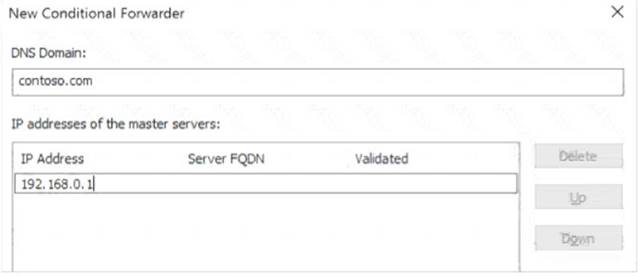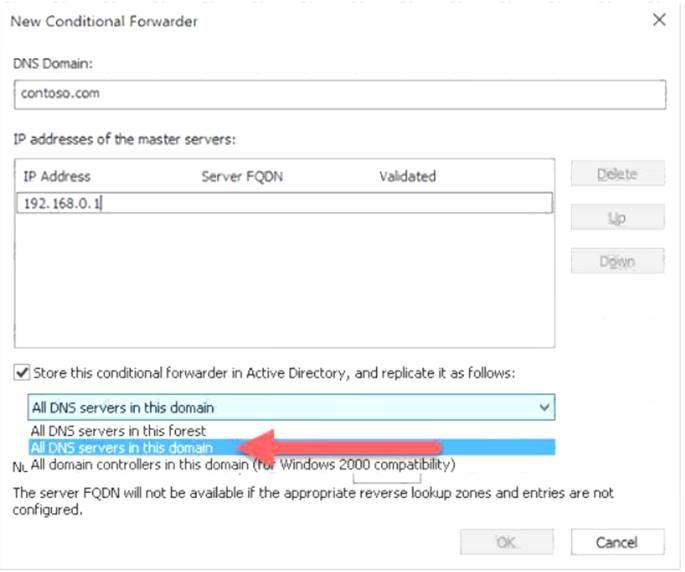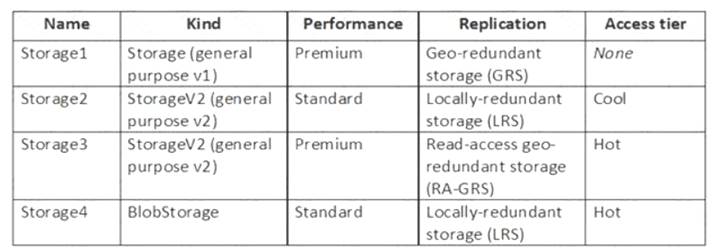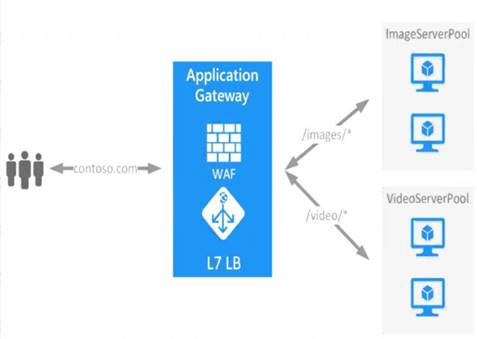- (Exam Topic 4)
You have the Azure virtual machines shown in the following table.
A DNS service is install on VM1.
You configure the DNS server settings for each virtual network as shown in the following exhibit.
You need 10 ensure that all the virtual machines can resolve DNS names by using the DNS service on VM1. What should you do?
Correct Answer:
B
An Azure AD DS DNS zone should only contain the zone and records for the managed domain itself.
A conditional forwarder is a configuration option in a DNS server that lets you define a DNS domain, such
as contoso.com, to forward queries to. Instead of the local DNS server trying to resolve queries for records in that domain, DNS queries are forwarded to the configured DNS for that domain. This configuration makes sure that the correct DNS records are returned, as you don't create a local a DNS zone with duplicate records in the managed domain to reflect those resources.
To create a conditional forwarder in your managed domain, complete the following steps:
* 1. Select your DNS zone, such as aaddscontoso.com.
* 2. Select Conditional Forwarders, then right-select and choose New Conditional Forwarder...
* 3. Enter your other DNS Domain, such as contoso.com, then enter the IP addresses of the DNS servers for th namespace, as shown in the following example:
* 4. Check the box for Store this conditional forwarder in Active Directory, and replicate it as follows, then select the option for All DNS servers in this domain, as shown in the following example:
* 5. To create the conditional forwarder, select OK.
Name resolution of the resources in other namespaces from VMs connected to the managed domain should now resolve correctly. Queries for the DNS domain configured in the conditional forwarder are passed to the relevant DNS servers.
Reference:
https://docs.microsoft.com/en-us/azure/virtual-network/virtual-networks-name-resolution-for-vms-and-role-insta https://docs.microsoft.com/en-us/azure/active-directory-domain-services/manage-dns
- (Exam Topic 4)
You have an Azure subscription that contains the storage accounts shown in the following table.
You need to identify which storage account can be converted to zone-redundant storage (ZRS) replication by requesting a live migration from Azure support.
What should you identify?
Correct Answer:
B
ZRS currently supports standard general-purpose v2, FileStorage and BlockBlobStorage storage account types.
- (Exam Topic 6)
Note: This question is part of a series of questions that present the same scenario. Each question in the series contains a unique solution that might meet the stated goals. Some question sets might have more than one correct solution, while others might not have a correct solution.
After you answer a question in this section, you will NOT be able to return to it. As a result, these questions will not appear in the review screen.
You have an Azure virtual machine named VM1. VM1 was deployed by using a custom Azure Resource Manager template named ARM1.json.
You receive a notification that VM1 will be affected by maintenance. You need to move VM1 to a different host immediately.
Solution: From the Update management blade, you click Enable. Does this meet the goal?
Correct Answer:
B
You would need to Redeploy the VM.
References: https://docs.microsoft.com/en-us/azure/virtual-machines/windows/redeploy-to-new-node
- (Exam Topic 6)
Note: The question is included in a number of questions that depicts the identical set-up. However, every question has a distinctive result. Establish if the solution satisfies the requirements.
Your company has an Azure Active Directory (Azure AD) tenant named weyland.com that is configured for hybrid coexistence with the on-premises Active Directory domain.
You have a server named DirSync1 that is configured as a DirSync server.
You create a new user account in the on-premise Active Directory. You now need to replicate the user information to Azure AD immediately.
Solution: You run the Start-ADSyncSyncCycle -PolicyType Initial PowerShell cmdlet. Does the solution meet the goal?
Correct Answer:
A
Reference:
https://blog.kloud.com.au/2016/03/08/azure-ad-connect-manual-sync-cycle-with-powershell-start-adsyncsynccy
- (Exam Topic 6)
You deploy an Azure Application Gateway.
You need to ensure that all the traffic requesting https://adatum.com/internal resources is directed to an internal server pool and all the traffic requesting https://adatum.com/external resources is directed to an external server pool.
What should you configure on the Application Gateway?
Correct Answer:
A
URL Path Based Routing allows you to route traffic to back-end server pools based on URL Paths of the request.
In the question there are two different path from where the traffic is getting generated as below https://adatum.com/internal
https://adatum.com/external
So in this case we can use URL path-based routing feature of Application Gateway.
Reference:
https://docs.microsoft.com/en-us/azure/application-gateway/url-route-overview